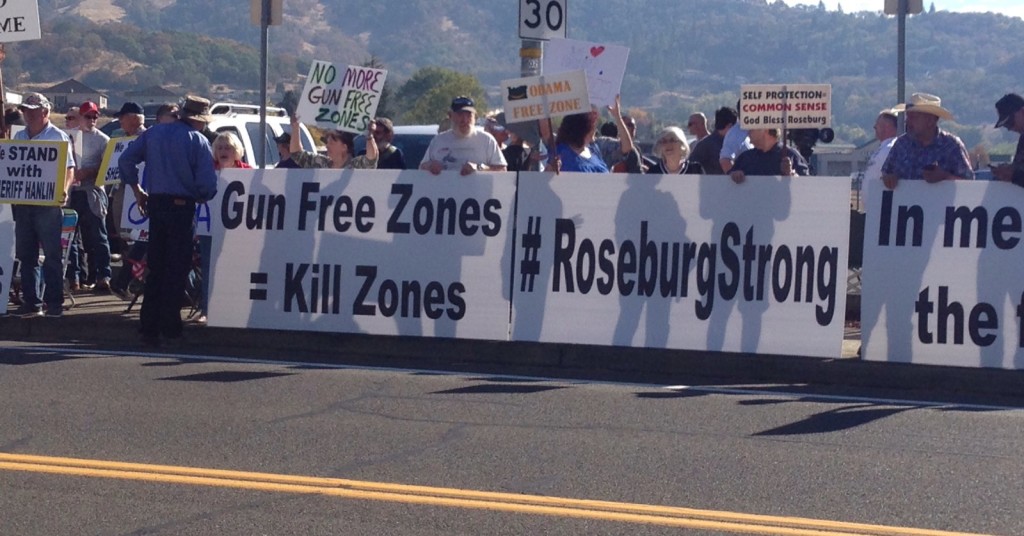A recent shooting at an Oregon community college is renewing calls to ban or control gun ownership as a means of quelling violence, but a largely overlooked 2007 Harvard University study shows that’s a bad idea.
Both President Obama and leading Democratic presidential candidate Hillary Clinton have rallied gun control advocates in the wake of a mass shooting at Umpqua Community College that left nine dead Oct. 1.

Obama told the Washington Post last week he may take executive action to impose new background checks on gun buyers, and a new licensing process with the Bureau of Alcohol, Tobacco, Firearms and Explosives for certain dealers.
The proposals follow 25 executive actions Obama imposed on gun ownership in the months following the Sandy Hook Elementary School shooting in December 2012.
“On Monday, Democratic presidential candidate Hillary Rodham Clinton listed the idea of changing the definition of who qualifies as a gun dealer as one of her top proposals to address gun violence,” the Post reported last week.
The political pressure for gun control, however, is also prompting some to point out it doesn’t work, as illustrated by a Harvard study released in 2007 that compared the correlation between violent crimes and gun control in numerous countries, Boston Magazine reports.
The article “Would Banning Firearms Reduce Murder and Suicide?” was published in Harvard’s Journal of Public Law and Policy by criminologist attorney Don B. Kates and Canadian criminologist professor Gary Mauser.
“There is a compound assertion that guns are uniquely available in the United States compared with other modern developed nations, which is why the United States has by far the highest murder rate. Although these assertions have been endlessly repeated, (the latter) is, in fact, false and (the former) is substantially so,” the authors wrote.
The data shows “correlations that nations with stringent gun controls tend to have much higher murder rates than nations that allow guns,” they wrote.
The study relies on data from the Centers for Disease Control, U.S. National Academy of Sciences and the United National International Study on Firearms Regulation to illustrate its point, according to BeliefNet.com.
Comparing the U.S. with England, which banned most guns by the late 1990s, researchers found “a negative correlation” showing “where firearms are most dense violent crime rates are lowest, and where guns are least dense, violent crime rates are highest.”
That’s the same conclusion researchers with the U.S. National Academy of Sciences reached in a 2004 study, as did a U.S. Centers for Disease Control study the year before, Kates and Mauser wrote.
“Armed crime, never a problem in England, has now become one. Handguns are banned but the Kingdom has millions of illegal firearms,” they wrote. “Criminals have no trouble finding them and exhibit a new willingness to use them. In the decade after 1957, the use of guns in serious crime increased a hundredfold. In the late 1990s, England moved from stringent controls to a complete ban on all handguns and many types of long guns. Hundreds of thousands of guns were confiscated from those owners law-abiding enough to turn them in to authorities.”
At the same time, “despite constant and substantially increasing gun ownership, the United States saw progressive and dramatic reductions in criminal violence,” according to the Harvard study.
The narrative about guns contributing to violence in the U.S. is perpetuated by the media in coordination with gun control advocates, according to Scott Bach, president of the Association of New Jersey Rifle and Pistol Clubs told Belief Net.
“Criminologists of all political persuasions, in over a dozen studies,” writes Bach, “estimate that firearms are used for protection against criminals several hundred thousand to 2.5 million times per year, often without a shot fired. This is a staggering statistic, but it’s not one you are likely to hear on the evening news. Why is it that you don’t hear about the homeowner who defended his family before the police could arrive; or the shopkeeper who saved his own life and the lives of his customers; or the woman who stopped her own rape and murder; or the teacher who stopped the school shooting?”
“Why? A study by the Media Research Center concluded media coverage of firearms is overwhelmingly biased. In a recent period, “television networks collectively aired 514 anti-gun stories, to a mere 46 that were pro-firearm, a ratio of more than 11-to-1 against firearms,” he told the news site.
And the biased coverage is intentional.
“And did you know that there is now an official propaganda manual that has been put out for gun control advocates?” Michael Snyder wrote in 18 Little Known Gun Facts That Prove That Guns Make Us Safer. “This manual actually encourages gun control advocates to emotionally exploit major shooting incidents to advance the cause of gun control.”
“The most powerful time to communicate is when concern and emotions are running at their peak,” Snyder quoted from the guide. “The debate over gun violence in America is periodically punctuated by high-profile gun violence incidents including Columbine, Virginia Tech, Tucson, the Trayvon Martin killing, Aurora and Oak Creek. When an incident such as these attracts sustained media attention, it creates a unique climate for our communications efforts.”
Leave a Comment
COMMENTS POLICY: We have no tolerance for messages of violence, racism, vulgarity, obscenity or other such discourteous behavior. Thank you for contributing to a respectful and useful online dialogue.